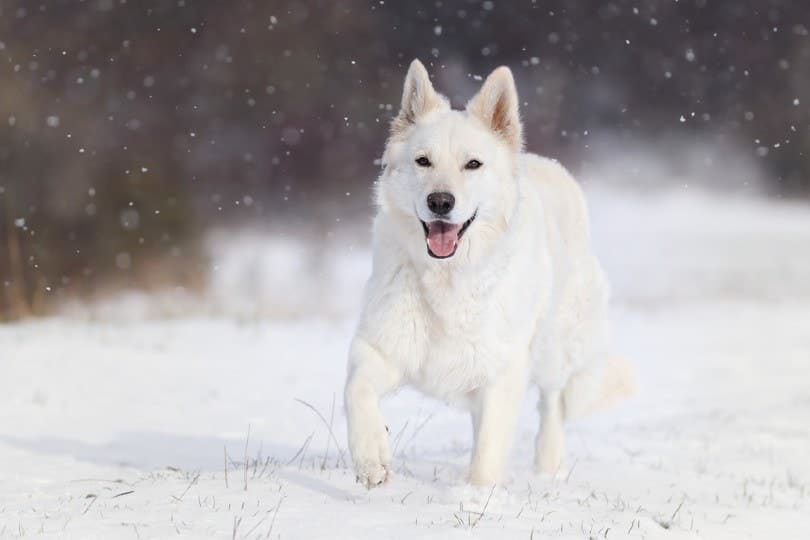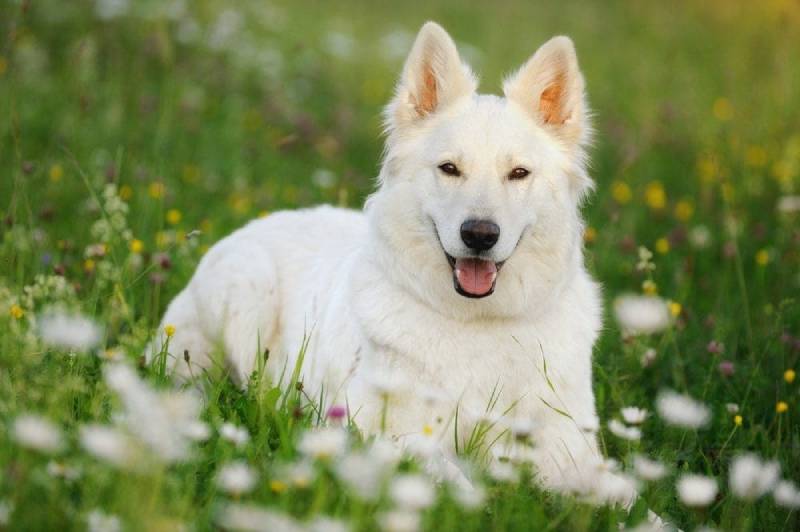In this article
View 8 More +The White Shepherd is a cousin to the German Shepherd. Although white German Shepherds have existed naturally as long as the original breed has been in existence, White Shepherds were intentionally bred in the US during the 20th Century before making their way to Switzerland, where they have been named the White Swiss Shepherd.
Bred to protect livestock, owners preferred their white color because it made them easier to differentiate from the wolves they were protecting against. However, the White Shepherd is a somewhat contentious breed. The American Kennel Club has refused to recognize them as a breed. A white color disqualifies German Shepherds from being registered with the AKC and the White Shepherd is not recognized as a separate breed. It is recognized by the FCI and in some other countries.
Breed Overview
Height:
22 – 25 inches
Weight:
60 – 80 pounds
Lifespan:
12 – 14 years
Colors:
White
Suitable for:
Owners looking for a loyal dog
Temperament:
Loving, loyal, protective, trainable, intelligent
The White Shepherd is, at heart, a German Shepherd. This means owners can enjoy the same traits that they would from the popular breed. Intelligent and trainable, they do need an authoritative figure during training, but they don’t respond well to harsh training.
White Shepherd Dog Breed Characteristics

White Shepherd Puppies

White Shepherds are uncommon dogs, which can make finding breeders difficult. It’s worth checking with German Shepherd breeders, of which there are many because some might have or know of White Shepherds. Otherwise, you will need to specifically look for White Shepherd or Swiss White Shepherd breeders. Because the breed isn’t recognized by the AKC, don’t be fooled by breeders claiming they’re worth more.
Although rare, White Shepherds can sometimes be found in shelters. There are a lot of German Shepherd breed-specific rescues, and you may be able to find White Shepherds here. Do try and determine the reason the dog has been abandoned and ask the shelter how the dog is with people and other animals. While the history of rescue dogs can be questionable, the rescue should know whether the dog gets on with other dogs and how it reacts to people.
If you do adopt, and you already have dogs, take your current canine companions to meet your prospective new pup. Take them for a walk together and see how they react to one another. While they will act differently at your home to how they act when they’re out, you should get a good sense of whether they will gel together.
Socialization and training are integral to a young dog’s development. This is especially true with dogs like White Shepherds. Their protective nature means they can be standoffish with strangers. Good socialization will help prevent this. Early training also ensures that you have good control over what is a strong breed. Start socializing and training as soon as you get your puppy home.
Temperament & Intelligence of the White Shepherd 🧠
The White Shepherd is a white German Shepherd, which means you can expect a dog with the same characteristics and traits as a German Shepherd. The German Shepherd is renowned for being intelligent and trainable and for being hard working. It does very well when given a task or job to perform, and if you don’t find ways to keep a German Shepherd busy, it may find its own entertainment.
This is a protective breed. They will have no qualms about looking after you or the rest of their human family, even if that means putting themselves at risk. This means that you need to teach a White Shepherd what is and what is not considered a threat, otherwise, you could have a difficult time ahead.
If left alone for too long, the White Shepherd can become bored and depressed. If you go out to work all day, consider getting a dog walker to come in, or look at breeds that are happy being given their own space.
Are These Dogs Good for Families? 🏡
The German Shepherd has become a very popular pet, while also still being popular as a service dog in a wide range of settings. Your White Shepherd will likely form a very close bond with all human family members and will guard young family members, protecting them from any potential harm. While this can be endearing, it means you need to take care if your child has friends around if they take part in rough play sessions.
The breed is usually gentle with children, but the White Shepherd is a big dog and even accidental bumps and collisions can cause injury, especially to toddlers and small infants. The WSD will appreciate any member of the family who provides walks or is willing to spend time playing.

Does This Breed Get Along with Other Pets? 🐶 😽
The White Shepherd can live with other pets, including cats and other dogs, but it will be a lot easier if you can introduce the dog to other pets when it is still young. If you adopt an older White Shepherd, try to determine whether it has any experience living with other animals. When it comes to smaller pets, always be cautious about letting small animals like rats and guinea pigs run around near a dog.
No matter how placid your pup seems, they might find the prospect of a small animal running by to be too tempting. Even if the dog doesn’t mean to harm a small pet, its size means that a playful batting of the paw will likely be enough to cause injury, or worse.

Things to Know When Owning a White Shepherd Dog:
The White Shepherd can make a very good pet. It is responsive, intelligent, and fiercely loyal. They are also high energy and high octane, requiring a lot of attention to ensure they are physically and mentally fulfilled. A bored White Shepherd will likely become a destructive White Shepherd, so it really is important that you offer appropriate stimulation.
Food & Diet Requirements 🦴
As a big dog that tends to require a lot of exercise, the White Shepherd has a hearty appetite. They will eat approximately three cups of good-quality dry kibble each day. Treats should not make up more than 10% of your dog’s daily diet, by calories, and you should try to give healthy treats. Dental treats can help fight plaque and tartar buildup while also offering something to chew.
If feeding wet food, follow the feeding instructions on the packet, making allowances for your dog’s activity levels, whether they are under or overweight, and whether your vet has made any recommendations regarding feeding amount.
You can feed a combination of wet and dry food. If you do so, ensure you reduce the amount of both. An easy way to do this is to feed half the recommended amount of dry food and half the recommended canned food.
Allow your dog free access to fresh drinking water at all times of day and night.

Exercise 🐕
The White Shepherd is a lively dog that requires plenty of exercise. Although they will enjoy going on walks with you, they will also benefit from more intense forms of exercise, especially those that combine physical activity with mental tasks.
Consider enrolling in some form of canine sport with your White Shepherd. It offers an opportunity for bonding, provides plenty of training opportunities, and also meets your dog’s stimulation requirements. They can do well in agility as well as in strength and stamina events. Even if you do take your White Shepherd to canine sports classes, walks are still beneficial. They offer the opportunity to socialize with other dogs and people. They also let your dog sniff and get some fresh air out of the house.
Provide a minimum of 60 minutes of walks per day, ideally split into two walks, and if you can provide more than this, do. There is no such thing as too much walking with a White Shepherd unless there are medical reasons to curtail exercise.
Training 🦮
The German Shepherd is used as a service dog in a wide variety of roles. They are still used as police dogs and for working with the armed forces, plus used as a guard dog, watchdog, and even as a herding or farm dog. This points to the fact that the breed is not only fearless, but it is also highly trainable, and the White Shepherd is no different in this regard. Start when your dog is young, avoid scolding or harshly punishing your dog, and use positive training techniques to get the most out of your training efforts.
Start socializing your dog as soon as possible. This means taking them to puppy classes as well as on regular walks. Take different routes on your walks and try to meet or pass as many different groups of people as possible. Ensure your dog is comfortable around people in uniform as well as runners, cyclists, walkers, and cars. Have family and friends visit the house to get your dog used to having visitors on their property. Even when your dog has matured, don’t let up with socialization. It should be an ongoing facet of your dog’s development.
Training should also start as soon as possible, and it involves more than teaching basic commands like sit and stay. Training means encouraging positive behaviors and discouraging negative ones. By starting young, you not only have a greater chance of teaching more commands, more easily, but it also teaches your dog to listen to you and pay attention to what you want.

Grooming ✂️
The White Shepherd does shed throughout the year as well as during the molting season. This means you should expect to find hair on the furniture and even on clothes pretty much throughout the year. It is also one of the reasons that you will want to brush your White Shepherd every day.
Brush your dog’s teeth at least three or four times a week. It can be difficult to brush an adult dog’s teeth if it isn’t accustomed to the process, so try and start when your dog is still a puppy. Brushing will help prevent or reduce plaque and tartar buildup. This should be backed up with regular dental checks at your vets and can be supplemented with the giving of dental treats. Dental treats alone are not enough to keep your dog’s teeth healthy.
Check inside your White Shepherd’s ears regularly and, when you hear their claws clicking on hard floors, get the clippers out and give them a trim. Typically, claws need trimming every two months or so, but this may be different for your dog, especially depending on whether they walk on concrete and other abrasive surfaces regularly or spend all their time running on grass.
Health and Conditions ❤️
German Shepherds are prone to hip and elbow dysplasia as well as conditions affecting their ears, and White Shepherds share the same genes, which means they share the same susceptibility to these conditions.
Dysplasia occurs when the bones do not develop properly, or they form in incorrect positions. It can cause discomfort and may be painful. Ultimately, it will likely lead to arthritis in the affected joint.
- Allergies
- Ear Problems
- Eye Problems
- Bloat
- Elbow Dysplasia
- Hip Dysplasia

Male vs Female
Males are bigger and heavier than females. They also tend to be braver and may be more aggressive. Females can be more territorial, thanks to their maternal instinct, and they are usually moodier than males.

3 Little-Known Facts About the White Shepherd Dog Breed
1. They Are White German Shepherds
The White Shepherd was intentionally bred from white German Shepherds. No other breed has gone into their development, which means that White Shepherds are German Shepherds. Other than the difference in coat color, they share the same characteristics.
2. White Shepherds Need Attention
Their loyalty and protective nature should be admired, but it also means that the White Shepherd forms a very close bond with their human and can become upset and even anxious or depressed if left alone for too long. If you go out to work all day, you might want to consider a different breed or have a walker come in and spend some time with your pup.
Provide lots of stimulating toys, make sure your pup is well exercised before you go, and try building up to longer periods out of the house.
3. They Are Intelligent and Athletic
While they can’t reach the kind of speeds of Greyhounds or Whippets, White Shepherds are no slouches and can top speeds of 30 miles per hour. They are also good at jumping, and climbing, and are very agile and athletic. The breed is also intelligent, which means that you will have to find lots of ways to meet their physical and mental needs. Canine sports, puppy classes, ongoing training, and lots of playtime will help ensure your White Shepherd is properly stimulated.

Final Thoughts
The White Shepherd is a German Shepherd with a white coat, which means prospective owners can expect an intelligent and athletic dog that forms a close bond with its humans, whom it will protect at all costs. Expect to provide a lot of exercise and keep on top of training. You will also need to groom your dog regularly. But your efforts will be rewarded with a loyal and loving family pet.
They get on well with children, although their size means you need to take some care around toddlers and small children, and if you’re looking for a hiking or even a running buddy, the White Shepherd is a sound choice.
See also:
- What to Do if My Dog Ate Chocolate: 3 Vet-Approved Steps to Follow
- My Dog Ate Charcoal! What Do I Do? Vet-Approved Advice
Featured Image Credit: ehasdemir, Shutterstock


















